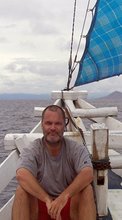 Repairing the Faces of
Repairing the Faces of By ANDREW GREENE
In seven years, Dr. Theddeus O.H. Prasetyono has notched close to 400 cleft surgeries in his scalpel and the
“I am fortunate to be a plastic surgeon,” the right-handed 39 year-old says in English. “I feel there needs to be a built-in motivation for every plastic surgeon working in
The still single surgeon, who goes by Teddy, is the Secretary General of the Indonesian Association of Plastic Surgeons. The IAPS works with the government run Jaring Pengaman Sosial (Social Safety Net) and the Dharmais Foundation to assist such patients.
“Our strength is helping those who have congenital disfigurements such as cleft lip or palette,” the
Currently, there are approximately 285,000 Indonesians who have a cleft lip, cleft palette, or both. With 1.25 per 1,000 Indonesian births being affected by CL/CP, the archipelago is home to nearly 6,000 new cases every year. The rate of occurrence for Indonesians, and for Asians in general, is 20 percent higher than that for Caucasians and more than double that for those of African ancestry
While the fetus is developing, the right and left sides of the lip and the roof of the mouth normally grow together. However, for some, the sections do not come together and a separation remains. This is a cleft.
An infant with a separation in the upper lip has a cleft lip while one with the defect in the roof of the mouth has a cleft palette. Since the lip and the palette develop independently of one another, a child may be born with a cleft in the lip, the palette, or both.
Teddy, who has trained in
Outside the cities the condition is much darker. “Many remain superstitious in the villages and believe that babies with cleft are cursed,” the diminutive man who has always wanted to be a doctor elaborated. “I’ve heard that some parents still hide their children in their homes if this happens.”
To combat this situation, IAPS sends Teddy and others on nationwide surgery tours. “We travel together in teams of 11 to 13 people,” he explained. “There are six plastic surgeons, two or three anesthesiologists, and four nurses. Local personnel also commonly work with us. During such tours we can operate on 80 to 120 patients in four days.”
Like most doctors, Teddy works long hours.
By day he works at the
Teddy feels that everything he does at UI, from the counseling to the surgery to the follow-up, is teaching. There are currently 25 residents learning their craft from the doctor.
By night he builds his private practice from room 105 at
“Counseling is very important for patients who are within the so-called ‘normal range,’ Teddy said. “Through counseling, I turn down perhaps two of these patients a month. Not every condition will be overcome through surgery.”
The other half of the patients requires reconstructive surgery. Surgically speaking, burn victims are the greatest test. “After their lives have been saved, plastic surgery becomes very important for them,” he explained. “Tendons in the hand are often destroyed by the fire and donated tendons are nearly always rejected so we must rely on transferring tendons from the same hand. Unfortunately, most of the time all of the tendons have been burnt.”
The 70-hour work weeks do not trouble Teddy. He is passionate about his profession, saying, “It was like falling in love the first time observing my teacher help burn patients. I saw there is a sense of art to it. That’s when I knew I was to be a plastic surgeon.”
This article was first published in KABAR Magazine which can be found at bookstores throughout Jakarta. It is a fine magazine that deserves a look at.


No comments:
Post a Comment